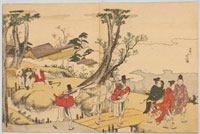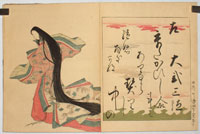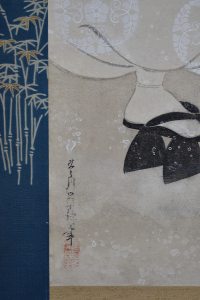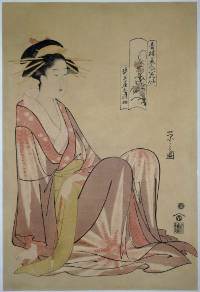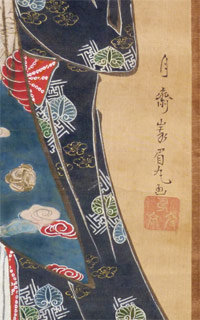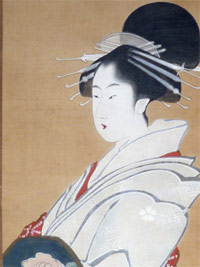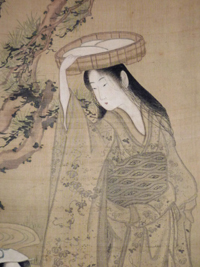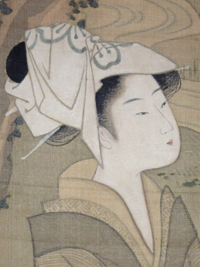Hosoda EISHI (1756-1829)

Click here to view image full size.
Two beauties examining tanzaku poetry cards from a set Ukiyo Genji hakkei, “Eight Views of Genji in the Floating World.” The designs stand alone but also form diptychs. This series compares scenes from the famous Tale of Genji novel written by the Lady Murasaki in the early 11th century with the Eight Views of Omi [Lake Biwa]. In the present case, Maboroshi rakugan (viz Katata rakugan, “Descending Geese at Katata”) is compared to chapter 41, Spirit Summoner, of the Tale of Genji where a poem composed by the Akashi Lady is in response to the grieving Genji’s poem after the nocturnal encounter with Murasaki which refers to the wild goose (aka Genji) having flown away. Published by Eijudo c 1797-99. Another impression is in the B.M., reg. no. 1931, 0427,0.8 and an impression is illustrated in Klaus J. Brandt, Hosoda Eishi, 1977, 119, no. 301. Provenance: Sold Sothebys, New York, 28/10/1980, lot 866.
Fine impression. Very good colour with yellow ground. Slight centre fold and very slight trimming, otherwise very good condition. Signed Eishi zu.
Status: Available
Hosoda EISHI (1736-1829)

Click here to view image full size.
An original painting, sumi and colour on silk, 33.25 x 12 in; 84.5 x 30.5 cms. Shows a parading oiran, a high class courtesan, beneath falling cherry blossom. A parade was held every April in the Yoshiwara under the spring cherry blossom. Her costume is decorated with a large golden koi swimming amongst water weeds. An elegant and refined painting of great delicacy typical of this painter who was of unusually high rank for an Ukiyo-e artist. His prints – usually of beauties – are equally elegant. He also had a considerable number of pupils, including Eisho, Eiri and Eisui who produced some exceptional compositions. Probably painted around 1795-1804.
Mount with some minor damage; painted area in very good condition. Signed Chobunsai Eishi hitsu with Eishi seal.
Status: Available

Click here to view image full size.
Hosoda EISHI (1756-1829)

Click here to view image full size.
An original painting, full colour on silk, 32.5 x 10 in; 82.5 x 25.5 cms. Shows a promenading courtesan under a full moon – presumably on the way to an assignation. She wears a vivid red over-garment decorated with iris and the under-garment has heavy mica applied. Eishi was of unusually high rank for an Ukiyo-e artist and is noted for his refined beauties – both painted and in woodblock form. They often have ink-wash backgrounds in the Edo-Kano technique learned as a pupil of Kano Eisen’in Michinobu (1730-90). His corpus is extensive and there are also many copies of his work. He had around thirty pupils including Eisho, Eiri and Eisui. Minor flaking of mica but in otherwise good condition. Signed Chobunsai Eishi hitsu with Eishi seal.
Status: Sold
Hosoda EISHI (1756-1829)
Click here to view image full size.
A fine original painting by one of the best known Ukiyo-e artists. This high ranking individual produced some of the most refined prints during the late 1780s and the 1790s. He had many pupils including Eisho, Eiri and Eisui. Shows a standing beauty painted c. late 1790s. One hand adjusts a hairpin, while the other holds a partly concealed letter. Image size 35.25 x 13 in; 89.5 x 33 cms. Exquisitely painted in full colour on silk. In very good condition with futo-maki ( thick wooden roll to preserve the painting from damage ) and fine new mount and box. Signed Chobunsai Eishi hitsu with Eishi seal.
Status: Sold
Hosoda EISHI (1756–1829) and Katsushika HOKUSAI (1760–1849)
Click here to view image full size.
One volume complete Nishikizuri onna sanjurokkasen, “The Thirty-Six Women Poets in Brocade Prints” published by Eijudo Nishimuraya Yohachi and dated on last postscript Kansei 9 hinoto mi “Kansei 9 [ 1797 ] mid-Winter” and stating that the calligraphy was written by thirty-six young girls, none over the age of fifteen. Date of publication Spring 1801 ( Kansei 13 kanoto tori haru ). Two prefaces followed by a double-page frontispiece by Hokusai and thirty-six double-page prints with a poetess at left and a poem in shikishi at right decorated with colour patterns. Two postfaces with colophon giving artist as Hosoi Chobunsai, with seals Hosoi and Chobunsai. Rare complete and as Jack Hillier wrote in The Art of the Japanese Book, Sotheby’s, vol. 1, p. 454: “The other book with colour prints by Eishi is one of the major masterpieces of the colour-printer’s art.” Provenance: Ex Hayashi collection ( large and small seals ) and Edmond de Goncourt with an annotation by him at end of second preface where he states that he purchased it from Hayashi in 1888 for 200 francs ( and sold, lot 1499, in Goncourt sale, 10/3/1897, Hotel Drouot, Paris ). There is also a small oval seal with a capital “G” running through the book. This appears to be another collector as it does not tally with Goncourt’s seals.
Old brocade covers and title slip, probably not original. Very fine impressions and colour. Minor backed wormage on preface and colophon, otherwise very good condition.
Status: Sold
Chobunsai EISHI (1756-1829)
Click here to view image full size.
An aiban from a set of four prints: Shiki warabe asobi, a series of prints comparing young children to the four seasons. Another from the set is illustrated in Estampes Japonaises. Collection des Musees royeaux d’Art et d’Histoire, Bruxelles, 1989, cat. 319, p. XXXIX ( incorrectly attributed to Eisho ). Published by Izumiya Ichibei 1795-6.
Very good impression, colour and condition. Full size. Signed Eishi.
Status: Sold
Chobunsai EISHI (1756-1829)

Click here to view image full size.
A parading oiran, Senzan of the Choji-ya, with her two kamuro Isoji and Hanaji. From a set Seiro moyo awase “Comparisons of Brothel Patterns.” Published by Nishimuraya Yohachi (Eijudo), c 1796-7. See Brandt, Hosoda Eishi, Eike Moog, 1977, 100. No. 263. Provenance: Ex Louis Gonse collection.
Fine impression. Exceptional colour. Fine condition.
Status: Sold
Hosoda EISHI (1756-1829)
Click here to view image full size.
A triptych representing Matsukaze, “The Wind in the Pines,” Chapter XVIII, from a set of triptychs Furyu yatsushi Genji, “Genji in Modern Dress.” Brandt, Hosoda Eishi, Stuttgart, 1977, lists nine from the series (this being no. 58, p. 116, illustrated p. 16). Based on the famous early 11th century novel Genji Monogatari written by Murasaki Shikibu. Shows court ladies, one playing a koto on the engawa far right, others welcoming the arrival of Prince Genji, far left. Published by Senichi, c. 1792. Provenance: Ex Worcester Art Museum and Louis W. Black collections, sold Sothebys N.Y., 4/3/1976, lot 122.
Extremely fine impression and perfect unfaded colours. Album backing, otherwise fine condition. Signed Eishi ga (with a small sumi insertion to read Eisui).
Status: Sold
Hosoda EISHI (1756-1829)
Click here to view image full size.
A small chuban print showing silkworm cultivation. Two girls feed mulberry leaves to the silkworms, another stands behind. A certain license was taken with this subject and designs did not necessarily faithfully follow the procedure or the girls truly depict the actual labourers. Published by Nishimuraya Yohachi, c 1800. This set (probably of 12) would have been printed two-to-a-sheet. Rare.
Fine impression and fine unfaded colours. Fine condition. Signed Eishi ga.
Status: Sold
Chobunsai EISHI (1756-1829)
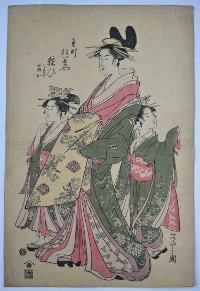
Click here to view image full size.
The parading courtesan Yosooi of Matsubaya with her kamuro Tomeki and Nioi. Published by Nishimuraya Yohachi c. 1800. She must have been a popular courtesan as she is depicted on many prints by various artists around this date.
Fine impression. Very good colour: Pale yellow ground. Very slight centre fold, otherwise very good condition. Signed Eishi zu.
Status: Sold
Choensai EISHIN (Fl. 1795-1817)
Click here to view image full size.
An original painting by a rare pupil of Hosoda Eishi. He designed some fine bijin prints, including rare okubi-e. Shows a beauty in heavy snow with billowing trousers, a heavy straw cape and tall geta elevating her above the snow. She holds a wide-brimmed hat in her right hand to ward off the flakes of snow. Another painting by Eishin of a similar subject is illustrated in Klaus Brandt, Hosoda Eishi, 1977, 569, E22. Sumi and colour on paper with extensive splashed gofun; 10.2 x 39.5 in; 25.5 x 100.5 cms. An interesting aspect of the painting are the stencilled white roundels on the trousers. Newly remounted but retaining the fine old chu-mawashi and ichimonji futai parts of mount which are yuzen dyed fabric from Kyoto. Painted c. 1800.
Signed Toyogawa Eishin fude; seal unread. Some careful restoration at base, otherwise in very good condition. Rare.
Status: Sold
Hosoda EISHI (1756-1829)

Click here to view image full size.
The courtesan Shizuka of the Shizutama-ya from the set of six prints Seiro bijin rokkasen, “Six Poems on Yoshiwara Beauties as Flowers.” One of the most beautiful sets of this period. Published 1794 by Nishimuraya Yohachi (Eijudo). The centre cartouche has a seasonal bloom, in this case the pink which was the emblem of Shizuka. See Klaus Brandt, Hosoda Eishi, 1977, 51, no. 172. Another impression was in the Popper sale catalogue, no. 138 and the impression from the Museum fur Ostasiatische Kunst, Berlin, is illustrated in the 1974 Tokyo Exhibition catalogue, no. 146.
Fine impression. Very good colour and condition. Yellow ground and mica on collar. Signed Eishi zu.
Status: Sold
Hosoda EISHI (1756-1829)

Click here to view image full size.
The parading courtesan Yosooi of Matsubaya with her kamuro Tomeki and Nioi. Not listed in Brandt. Published by Nishimuraya Yohachi (Eijudo) c 1800. She must have been a popular courtesan as she is depicted on many prints by various artists around this date.
Fine impression. Very good colour: Pale yellow ground. Very slight centre fold, otherwise very good condition. Signed Eishi zu.
Status: Sold
Hosoda EISHI (1756-1829)
Click here to view image full size.
A parading courtesan, Senzan of the Choji-ya house, with her two kamuro, Isieji and Hanaji. From a set of seven prints Seiro moyo awase, “A Comparison of Patterns of the Green houses.” Published by Eijudo, 1796-7. The title on a teacup. A luxurious yellow ground. See Klaus J. Brandt, 1977, no. 263, p. 146. A fine set. Rare.
Fine impression. Extremely fine, unfaded colour. Fine condition: Untrimmed with extra paper at left. A benchmark example for prints of this period. Signed Eishi zu.
Status: Sold
Hosoda EISHI (1756-1829)
Click here to view image full size.
The courtesan Shizuka of the Shizutama-ya from the set of six prints: Seiro bijin rokkasen, “Six Poems on Yoshiwara Beauties as Flowers.” One of the most beautiful sets of this period published 1794 by Eijudo. The centre cartouche has a seasonal bloom, in this case the pink which was the emblem of Shizuka. See Klaus Brandt, Hosoda Eishi, 1977, 51, no 172. Another impression was in the Popper sale cat. no 138 and the impression from the Museum fur Ostasiatische Kunst, Berlin, is illustrated in the 1974 Tokyo Exhibition catalogue, no 146.
Fine impression. Very good colour and condition. Yellow ground and mica on collar. Signed Eishi zu.
Status: Sold
Hosoda EISHI (1756-1829)

Click here to view image full size.
An extremely rare hosoban showing the oiran Hanaogi with her two kamuro from the House of Ogi. This appears to have been from a series as I had another design from the set in my Catalogue 8, 1972, no 38, showing Hinazuru of Choji-ya. Another Eishi hosoban appeared in the Sotheby sale catalogue, July 1963, lot 195. A rare format for anything other than actor prints during this period. Published c 1792. Ex Mellor and P & L Warnock collections. Illustrated in The Floating World Exhibition: Japan’s World of Transient Pleasures, The Art Gallery of South Wales, Sydney, 1994, no. C6.
Very good impression and colour. Printed in tones of pale mauve and grey with details in yellow. Light yellow ground. Some slight soil. Signed Eishi ga.
Status: Sold
Utagawa TOYOKUNI I (1769-1825)

Click here to view image full size.
A surimono showing the actor Ichikawa Danjuro II as Soga no Goro Tokimune holding the giant arrow prior to sharpening it on the large wetstone from the play Yanone Goro. From a series of surimono that paid tribute to the various generations of the Danjuro family. There are two versions of this set of surimono and some ambiguity as to which is the earlier. They are known with blank borders, lacking metallic pigments and signed Ko Toyokuni hitsu (except one design signed Toyokuni II and probably issued in 1833). The other, as here, is signed Toyokuni hitsu, has metallic pigments and the emblem of the Gogawa Poetry Club around the border. The poets were also changed for this issue. It seems that the first version was issued by the Danjuro Fan Club in 1825 and that the reissue, c 1830s, was by the Gogawa. One poem by Ryueishi. The finest design from the set.
Very fine impression with metallic pigments. Fine colour and condition. Signed Toyokuni hitsu.
Status: Available
Ichirakutei EISUI (Active 1790-1823)

Click here to view image full size.
A fine okubi-e (“large head”) portrait of the courtesan Shizuka of the Tama-ya House. Eisui, like the other main pupils of Eishi, produced some of the finest bust-portraits in Ukiyo-e. Published by Maruya Bunemon c late 1790’s. Other impressions illustrated in Klaus J. Brandt, Hosoda Eishi, page 72, 524, no. C35, catalogued p. 231, and the Library of Congress, FP2-JPD, no. 1912. Extremely Rare.
Very good impression. Good colour. Slight soil, otherwise good condition. Full sze. Signed Ichirakutei Eisui ga.
Status: Available
Tsukioka YOSHITOSHI (1839-1892)
Click here to view image full size.
A triptych showing the exorcism of the evil fox of Princess Osakabe by Miyamoto Musashi. The story relates how Musashi is the only warrior brave enough to enter Himeji castle which is haunted by the princess. He pursues her and finally cannot resist touching her which exorcises the evil foxes who can be seen surrounding the princess. In gratitude she presents him with a sword (seen here on middle and left sheet). Published 1863 by Yamazakiya Seishichi.
Very good impression and colour. Slight creasing, otherwise good condition. Signed Ikkaisai Yoshitoshi ga.
Status: Sold
Torii KIYOMASU II (Fl. c 1720s-1760)

Click here to view image full size.
An early print showing the actor Sanogawa Ichimatsu. He gained early recognition as a child actor. Published by Urokogata-ya hammoto, c mid 1730s. Ex collection Dr E.F. Rare.
Fine impression. Urushi beni-e with hand-applied colour: tan, blue, yellow, orange, light and dark beni and lacquered sumi over an embossed pattern. Album backing and light soil, otherwise good condition. Signed Eishi Torii Kiyomasu hitsu.
Status: Sold
Tsukioka YOSHITOSHI (1839-1892)

Click here to view image full size.
A triptych showing from left to right the actors: Seki Sanjuro III as Nippon Daemon (above) and Ichimura Uzaemon XIII as Benten Kozo Kikunosuke. Centre: Nakamura Shikan IV as Nango Rikimaru. Right: Iwai Kumesaburo III as Akaboshi Juzaburo (above) and Kawarasaki Gonjuro I as Tadanobu Rihei. The group of five dandy-thieves in Aoto zoshi hana no nishiki-e or Shiranami gonin otoko. A famous play written by Kawatake Mokuami, this being the first performance at the Ichimura-za Theatre in 3/1862. Published 3/1862 by Seibundo (Gifuya Seishichi). An extremely rare and early work: Not listed in Keyes.
Fine impression and colour. Slightly trimmed around, otherwise very good condition. Signed Ikkaisai Yoshitoshi ga.
Status: Sold
Gessai GABIMARU (Fl. c 1810)
Click here to view image full size.
A beautiful painting of a parading courtesan. A follower of Chobunsai Eishi in the Bunka period. There are works by him signed Chobunsai, so he may have been related to Eishi. Full colour on silk, 29.5 x 5.75 in; 75 x 14.5 cms. Painting in good condition. Mount is old and the painting should either be framed or remounted. Signed Gessai Gabimaru ga.
Status: Sold
Kubo SHUMMAN (1757-1820)
Click here to view image full size.
A fine painting showing a seated girl fulling cloth ( a process of beating which eliminated the dirt and other impurities ) with another standing beauty holding beaten cloth in a wooden tray on her head. This scene represents Mishima, or Toi, Province of Settsu. One of the Six Crystal ( Tama ) Rivers. ( Toi is the alternative name of the river and the word for beating cloth. ) This was probably Shumman’s most celebrated subject. He produced a set of six prints on this theme published by Fushimiya Zenroku, c 1787. One of the most beautiful 18th century sets, and together with a night triptych showing people returning from a poetry reading, is considered his masterpiece. The prints and the known paintings of this subject use the benigirai style, “red avoiding” pioneered by Shumman, Eishi and Shuncho. Shumman, a man of great sophistication, designed only a few prints before concentrating on surimono and printing and issuing some of the finest in this format. ( See The Japanese Print A New Approach, J. Hillier, pp. 102-104: “Probably no artist except Choki has achieved so high a reputation on such a small number of prints.” ) He also excelled at painting, book illustration and light verse. Painted on silk in tones of sumi, very light green, gofun and a small touch of red on the girls’ lips. Image size: 36 x 12 in; 91.5 x 30.5 cms. Other versions of this subject are in the BM ( 1922.2-13.01 ) and the Freer Gallery of Art ( FI903.62 ), gift of Charles Freer. Painted c early 1790s. Slight loss of gofun and very minor spotting, but otherwise in very good condition. Interesting old mount. Exhibited in 1995 at Shunsen Museum in Nanamashi prefecture, Nikushitsu ukiyoe meisaku ten, hosted by Mr Keizaburou Yamaguchi, p. 40, no, 37. Painting guaranteed by Mr Narazaki, the box being signed and dated 1988 by him. Signed Shosado Shumman, with circular Shumman seal.
Status: Sold
Shunkosai HOKUEI (Active 1824-1837)
Click here to view image full size.
Iwai Shijaku I as Kowagi Atsumori and Nakamura Utaemon III as Kumagai Jiro Naozane in Gempei Tsutsuji, performed 2/1832 at the Kado Theatre. Published by Honya Seishichi. This is the second state of three: The first edition also has carver’s seal and various de-luxe embellishments. The third state lacks seals and has the actors’ names in blue top left ( one changed ) for a performance the following year 3/1833.
Fine impression and colour. One flattened crease, otherwise very good condition. Signed Shunkosai Hokuei ga.
Status: Sold
Shikyusai EIRI (Fl c 1790-1800)
Click here to view image full size.
The courtesan Bando Oume of the Hasegawa-cho with the boy No Shiomatsu and O-tsui of Fujiya from a set Furyu juni-gatsu geisha meimyo awase, “Elegant Twelve Months Showing Various Famous Geisha.” Possibly New Year on the way to Niwaka festivities. Published by Yama-cho, c 1790-1800. A rare design by a rare artist. Possibly a pupil of Eishi.
Fine impression and colour. Exceptional retention of the pigments. Trimmed at the top, otherwise very good condition. Signed Rekisentei Eiri ga.
Status: Sold
Chokosai EISHO (Active 1780-1800)

Click here to view image full size.
The courtesans Hinazuru, Origiku and Misayama of the Chojiya House. The most prolific of Eishi’s pupils who produced some outstanding bust portraits. Published by Yamaguchiya Chusuke, c late 1790’s. Another impression is in the Chazen Museum of Art, Madison, acc. no. 1984.215.
Very good impression and colour. There is a variant impression with different colours. Slight soil, otherwise good condition. Signed Eisho ga.
Status: Sold
Kubo SHUNMAN (1757-1820)

Click here to view image full size.
Mishima, or Toi, Province of Settsu. The best desigm from an exquisite set of six prints showing graceful young women, girls and, in two instances, young men representing the Six Crystal (Tama) Rivers. These streams were noted for the purity of their water. The prints are in benigirai style, “red avoiding,” a technique pioneered by Shunman, Eishi and Shuncho. Shows a seated girl fulling cloth (hence Toi which is the alternative name of the river and the word for beating cloth) with three other beauties near the village of Mishima. A light shower passes by in the background. Shunman, a man of great sophistication, designed only a few prints before concentrating on surimono and printing and issuing some of the finest in this format. (See The Japanese Print: A New Approach, J. Hillier, pp. 102-104 where he says “Probably no artist except Choki has achieved so high a reputation on such a small number of prints.”) He also excelled at painting, book illustration and light verse. Published by Fushimiya Zenroku, c 1787. (A later edition was published by Tsutaya with less harmonious colours.) One of the most beautiful 18th century sets, and together with a night triptych showing people returning from a poetry reading, is considered his masterpiece. The complete set (trimmed) is illustrated in the Gale Catalogue Of Japanese Paintings & Prints, J. Hillier, Routledge, 1970, number 133 (a) – (f). Provenance: Originally purchased from me in 2008. Rare.
Fine impression. The centre female’s kimono blind-printed. Very good colour: printed only in tones of grey, light yellow and light pink, with touches of light red on the tree. Very small repaired wormhole, otherwise extremely good condition with extra paper at left. Probably untrimmed (whereas illustrated examples all seem to be trimmed somewhere). Signed Shunman with seal Shunman.
Status: Sold
Kubo SHUNMAN (1757-1820)

Click here to view image full size.
Chobu, Province of Musashi from an exquisite set of six prints showing graceful young women, girls and, in two instances, young men representing the Six Crystal (Tama) Rivers. These streams were noted for the purity of their water. The prints are in benigirai style, “red avoiding,” a technique pioneered by Shunman, Eishi and Shuncho.Shows a girl washing stripes of cloth in the stream. In fact, this design conjoins with the previous print in the set of six prints. Shunman, a man of great sophistication, designed only a few prints before concentrating on surimono and printing and issuing some of the finest in this format. (See The Japanese Print: A New Approach, J. Hillier, pp. 102-104 where he says “Probably no artist except Choki has achieved so high a reputation on such a small number of prints.”) He also excelled at painting, book illustration and light verse. Published by Fushimiya Zenroku, c 1787. (A later edition was published by Tsutaya with less harmonious colours.) One of the most beautiful 18th century sets, and together with a night triptych showing people returning from a poetry reading, is considered his masterpiece. The complete set (trimmed) is illustrated in the Gale Catalogue Of Japanese Paintings & Prints, J. Hillier, Routledge, 1970, number 133 (a) – (f). Provenance: Originally purchased from me in 2008. Rare.
Fine impression with some blind-printing. Very good colour: printed only in tones of grey, light yellow and light pink, with touches of light red on the tree. Very small repaired wormhole, otherwise extremely good condition with extra paper at left. Probably untrimmed (whereas illustrated examples all seem to be trimmed somewhere). Signed Shunman with seal Shunman.
Status: Sold
Katsushika HOKUSAI (1760 – 1849)
Click here to view image full size.
A rare surimono from the series Umazukushi, “A Series of Horses” published 1822 ( Year of the Horse ). Shows the banks of the Sumida river, Komatomeishi, with the stone used for tethering horses bottom centre. This surimono is one of three that form a triptych. The complete set is in the Rijksmuseum, Amsterdam ( 1958: 293-294-295 ) and is illustrated in Matthi Forrer, Hokusai, Rizzoli, 1988, no. 265, p. 238 and elsewhere. The other two surimono were also in the Gerhard Schack collection, illustrated in Surimono, 1970, 77-78. Ex collection H. de Winiwater ( seal top right ).
Fine impression with gold and silver. Some soil and loss of the gold. Signed Fusenkyo Iitsu no fude.
Status: Sold
Artists
( A to Z )
Kyogado ASHIKUNI ( Fl. c. 1807 – 1818 )
Gigado ASHIYUKI ( Fl. c. 1814 – 1833 )
Ki BAITEI ( 1734 – 1810 )
Takizawa BAKIN ( 1767 – 1848 )
Ono BAKUFU ( 1888 – 1976 )
Georges BIGOT ( 1860 – 1927 )
Kawamura BUMPO ( 1779 – 1821 )
Ippitsusai BUNCHO ( Fl. c. 1765 – 1792 )
Toyohara CHIKANOBU ( 1838 – 1912 )
Kishi CHIKUDO ( 1826 – 1897 )
Tsubaki CHINZAN ( 1801 – 1854 )
Eishosai CHOKI ( Fl. c. 1756 – 1808 ). See also SHIKO
Rekisentei EIRI ( Fl. c. 1790 – 1800 )
Keisai EISEN ( 1790 – 1848 )
Hosoda EISHI ( 1756 – 1829 )
Hosoda EISHO ( Fl. c. 1780 – 1800 )
Ichirakutei EISUI ( Fl. c. 1790 – 1823 )
Kikugawa EIZAN ( 1787 – 1867 )
Hirano HAKUHO ( 1879 – 1957 )
Elizabeth KEITH ( 1887 – 1956 )
Imao KEINEN ( 1845 – 1924 )
Yashima GAKUTEI ( 1786 – 1868 )
Ogata GEKKO ( 1859 – 1920 )
Adachi GINKO ( Fl. c. 1847 – 1897 )
Matsumura GOSHUN ( 1752 – 1811 )
GYOSAI. See Kawanabe KYOSAI
Hirano HAKUHO ( 1879 – 1957 )
Suzuki HARUNOBU ( 1724 – 1770 )
Kawase HASUI ( 1883 – 1957 )
Kitagawa HIDEMARO ( Fl. c. early 19th century )
Kinoshita HIRONOBU ( Fl. c. 1851 – 1870 )
Gosotei HIROSADA ( Fl. c. 1847 – 1863 )
Ichiryusai HIROSHIGE ( 1797 – 1858 )
Ichiryusai HIROSHIGE II ( 1826 – 1869 )
Ando HIROSHIGE III ( 1843 – 1894 )
Nakamura HOCHU ( Fl. c. late 18th to early 19th century )
Sakai HOITSU ( 1761 – 1828 )
Totoya HOKKEI ( 1780 – 1850 )
Teisai HOKUBA ( 1771 – 1844 )
Shunkosai HOKUEI (Active 1824-1837)
Katsushika HOKUGA ( Fl. c. 1830 )
Shotei HOKUJU ( Fl. c. 1789 – 1818 )
Katsushika HOKUSAI ( 1760 – 1849 ). Also used numerous other names such as: SORI, SHUNRO, SHINSAI
Shokosai HOKUSHU ( Fl. c. 1808 – 1832 )
KEISAI. See Kitao MASAYOSHI
Suzuki KIITSU ( 1796 – 1858 )
Kitagawa KIKUMARO ( Fl. c. ? – 1830 ). See TSUKIMARO
Kobayashi KIYOCHIKA ( 1847 – 1915 )
Torii KIYOHIRO ( Fl. c. 1737 – 1771 )
Torii KIYOMASA ( Fl. c. 1700 – 1722 )
KIYOMINE. See Torii KIYOMITSU II
Torii KIYOMITSU ( 1735 – 1785 )
Torii KIYOMITSU II ( 1787 – 1868 ). See KIYOMINE
Torii KIYONAGA ( 1752 – 1815 )
Torii KIYONOBU ( 1664 – 1729 )
Torii KIYONOBU II ( 1706 – 1763 )
Torii KIYOTSUNE ( Fl. c. 1757 – 1779 )
Isoda KORYUSAI ( Fl. c. 1767 – 1788 )
Ohara KOSON ( 1877 – 1945 ). See SHOSON
Torii KOTONDO ( 1900 – 1976 )
Toyohara KUNICHIKA ( 1835 – 1900 )
Utagawa KUNIHIRO ( Fl. c. 1815 – 1843 )
Ichiunsai KUNIHISA ( 1832 – 1891 )
Utagawa KUNINAO ( 1793 – 1854 )
Utagawa KUNISADA ( 1786 – 1865 )
Utagawa KUNISADA II ( 1823 – 1880 )
Utagawa KUNISATO ( ? – 1858 )
Utagawa KUNITERU ( 1808 – 1876 )
KUNITERU. See Utagawa SADASHIGE
Utagawa KUNITERU II ( 1829 – 1874 )
Utagawa KUNIYASU ( 1794 – 1832 )
Ichiyusai KUNIYOSHI ( 1797 – 1861 )
Santo KYODEN. See Kitao MASANOBU
Kawanabe KYOSAI ( 1831 – 1889 ). See GYOSAI
Okumura MASANOBU ( 1686 – 1764 )
KitaoMASANOBU ( 1761 – 1816 ). See Santo KYODEN
Kitao MASAYOSHI ( 1764 – 1824 ). See KEISAI
Oishi MATORA ( 1794 – 1833 )
Hishikawa MORONOBU ( Fl. c. 1618 – 1694 )
Nishimura NANTEI ( 1775 – 1834 )
Utagawa NOBUKATSU ( Fl. c. 1830 – 1844 )
Watanabe NOBUKAZU ( Fl. c. late 19th century )
Hishikawa RYUKOKU ( Fl. c. 1808 – 1816 )
Jokei RYUKOSAI ( Fl. 1772 – 1816 )
Gokitei SADAFUSA ( Fl. c. 1825 – 1850 )
Hasegawa SADAHARU ( Fl. c. 1830 – 1844 )
Gokotei SADAKAGE ( Fl. c. 1818 – 1844 )
Utagawa SADAHIDE ( 1807 – 1873 )
Hasegawa SADANOBU ( 1809 – 1879 )
Utagawa SADASHIGE ( Fl. c. mid 19th century ). See KUNITERU
Gofutei SADATORA ( Fl. c. 1825 )
Yamaguchi SHIGEHARU ( 1803 – 1853 )
Kitao SHIGEMASA ( 1739 – 1820 )
Nishimura SHIGENAGA ( 1697 ? – 1756 )
Nishimura SHIGENOBU ( Fl. c. 1724 – 1735 )
SHIKO. See Eishosai CHOKI
Ryuryukyo SHINSAI ( 1764 – 1820 )
Ito SHINSUI ( 1898 – 1972 )
Kojima SHOGETSU ( Fl. c. 1880 – 1890 )
SHOSON. See Ohara KOSON
Takahashi SHOTEI ( 1871 – 1945 )
Yamamoto SHOUN ( 1870 – 1965 )
Yamakawa SHUHO ( 1898 – 1944 )
Katsukawa SHUNCHO ( Fl. c. 1780 – 1795 )
Takehara SHUNCHOSAI ( Fl. c. 1772 – 1801 )
Katsukawa SHUN’EI ( 1762 – 1819 )
Katsukawa SHUNKO ( 1743 – 1812 )
Hishikawa SHUNKYO ( Fl. c. early 19th century )
Kubo SHUNMAN ( 1757 – 1820 )
Katsukawa SHUNSEN ( Fl. c. 1762 – 1830 )
Natori SHUNSEN ( 1886 – 1960 )
Gatoken SHUNSHI ( Fl. c. 1820 – 1828 )
Katsukawa SHUNSHO ( 1726 – 1792 )
Katsukawa SHUNTEI ( 1770 – 1820 )
Katsukawa SHUNZAN ( Fl. c. 1782 – 1798 )
Yamaguchi SOKEN ( 1759 – 1834 )
Ikeno TAIGA ( 1723 – 1776 )
Katsukawa TERUSHIGE ( Fl. c. 1715 – 1725 )
Mori TETSUZAN (1775-1841)
Migita TOSHIHIDE ( 1863 – 1925 )
Mizuno TOSHIKATA ( 1866 – 1908 )
Okumura TOSHINOBU ( Fl. c. 1717 – 1750 )
Utagawa TOYOHARU ( 1735 – 1814 )
Utagawa TOYOHIRO ( 1773 – 1828 )
Utagawa TOYOKUNI ( 1769 – 1825 )
Utagawa TOYOKUNI II ( 1777 – 1835 ). See TOYOSHIGE
Yamamura TOYONARI ( 1885 – 1942 )
Ishikawa TOYONOBU ( 1711 – 1785 )
TOYOSHIGE. See Utagawa TOYOKUNI II
TSUKIMARO. See Kitagawa KIKUMARO
Kitano TSUNETOMI ( 1880 – 1947 )
Toyokawa UMEKUNI ( Fl. c. 1816 – 1826 )
Kitagawa UTAMARO ( 1753 – 1806 )
Kitagawa UTAMARO II ( ? – 1831 )
Inoue YASUJI ( 1864 – 1889 )
Hiroshi YOSHIDA ( 1876 – 1950 )
Ipposai YOSHIFUJI ( 1828 – 1887 )
Utagawa YOSHIIKU ( 1833 – 1904 )
Utagawa YOSHIKATA ( Fl. c. 1841 – 1864 )
Utagawa YOSHIKAZU ( Fl. c. 1850 – 1870 )
Toyokawa YOSHIKUNI ( Fl. c. 1803 – 1840 )
Utagawa YOSHIMUNE ( 1817 – 1880 )
Ichiyosai YOSHITAKI ( 1841 – 1899 )
Utagawa YOSHITORA ( Fl. c. 1850 – 1880 )
Taiso YOSHITOSHI ( 1839 – 1892 )
Utagawa YOSHITSURU ( Fl. c. 1840 – 1850 )
Ichieisai YOSHITSUYA ( 1822 – 1866 )
Mori YOSHIYUKI ( 1835 – 1879 )
Shibata ZESHIN ( 1807 – 1891 )
Chokosai EISHO (active 1790s)
Click here to view image full size.
An aiban showing the seated courtesan Somenosuke of Matsubaya reading a hand scroll. From the set Kakuchu bijin-kisoi, “Three Patron Saints of Poetry in the Gay Quarters.” Eisho was the most successful of Eishi’s pupils. Published c 1790s by Yamaguchi Chusuke. Another from the set illustrated in A Treasury of Japanese Wood Block Prints, Sadao Kikuchi, no 694. Illustrated in Ukiyo-e Taikei, vol. 6, no. 216.
Very good impression and colour. Thinned area top border, otherwise very good condition. Signed Eisho ga.
Status: Sold
Kubo SHUNMAN (1757–1820)
Click here to view image full size.
Mishima, or Toi, Province of Settsu. The best design from an exquisite set of six prints showing graceful young women, girls and, in two instances, young men representing the Six Crystal ( Tama ) Rivers. These streams were noted for the purity of their water. The prints are in benigirai style, “red avoiding”, a technique pioneered by Shunman, Eishi and Shuncho. Shows a seated girl fulling cloth ( hence Toi which is the alternative name of the river and the word for beating cloth ) with three other beauties near the village of Mishima. A light shower passes by in the background. Shunman, a man of great sophistication, designed only a few prints before concentrating on surimono and printing and issuing some of the finest in this format. ( See The Japanese Print A New Approach, J. Hillier, pp. 102 – 104: “Probably no artist except Choki has achieved so high a reputation on such a small number of prints.” ) He also excelled at painting, book illustration and light verse. Published by Fushimiya Zenroku, c 1787. ( A later edition was issued by Tsutaya with less harmonious colours. ) One of the most beautiful 18th century sets, and together with a night triptych showing people returning from a poetry reading, is considered his masterpiece. Rare.
Fine impression. The centre female’s kimono blind-printed. Very good colour: printed only in tones of grey, light yellow and light pink, with touches of light red on the tree’s leaves. Very small repaired wormhole, otherwise extremely good condition with extra paper at left. Probably untrimmed ( whereas illustrated examples all seem to be trimmed somewhere ). Signed Shunman with seal Shunman.
Status: Sold
Kubo SHUNMAN (1757–1820)
Click here to view image full size.
Chobu, Province of Musashi from an exquisite set of six prints showing graceful young women, girls and, in two instances, young men representing the Six Crystal ( Tama ) Rivers. These streams were noted for the purity of their water. The prints are in benigirai style, “red avoiding”, a technique pioneered by Shunman, Eishi and Shuncho. Shows a girl washing stripes of cloth in the stream. In fact, this design conjoins with the following in the set of six prints. Shunman, a man of great sophistication, designed only a few prints before concentrating on surimono and printing and issuing some of the finest in this format. ( See The Japanese Print A New Approach, J. Hillier, pp. 102 – 104: “Probably no artist except Choki has achieved so high a reputation on such a small number of prints.” ) He also excelled at painting, book illustration and light verse. Published by Fushimiya Zenroku, c 1787. ( A later edition was issued by Tsutaya with less harmonious colours. ) One of the most beautiful 18th century sets, and together with a night triptych showing people returning from a poetry reading, is considered his masterpiece. Rare.
Fine impression with some blind printing. Very good colour: printed only in tones of grey, light yellow and light pink, with touches of light red on the tree’s leaves. Very small repaired wormhole, otherwise extremely good condition with extra paper at left. Probably untrimmed ( whereas illustrated examples all seem to be trimmed somewhere ). Signed Shunman with Shunman seal.
Status: Sold
Kubo SHUNMAN (1757-1820)
Click here to view image full size.
Mishima, or Toi, Province of Settsu. The best design from an exquisite set of six prints showing gracefull young women, girls and, in two instances, young men representing the Six Crystal ( Tama ) Rivers. These streams were noted for the purity of their water. The prints are in benigirai style, “red avoiding”, a technique pioneered by Shunman, Eishi and Shuncho. Shows a seated girl fulling cloth ( hence Toi which is the alternative name of the river and the word for beating cloth ) with three other beauties near the village of Mishima. A light shower passes by in the background. Shunman, a man of great sophistication, designed only a few prints before concentrating on surimono and printing and issuing some of the finest in this format. ( See The Japanese Print A New Approach, J. Hillier, pp. 102 – 104: “Probably no artist except Choki has achieved so high a reputation on such a small number of prints.” ) He also excelled at painting, book illustration and light verse. Published by Fushimiya Zenroku, c 1787. ( A later edition was issued by Tsutaya with less harmonious colours. ) One of the most beautiful 18th century sets, and together with a night triptych showing people returning from a poetry reading, is considered his masterpiece. Rare.
Fine impression. The centre female’s kimono blind-printed. Very good colour: printed only in tones of grey, light yellow and light pink, with touches of light red on the tree’s leaves. Minor marks, otherwise very good condition. Probably untrimmed ( whereas illustrated examples all seem to be trimmed somewhere ). Signed Shunman with Shunman seal.
Status: Sold
Toyohara KUNICHIKA (1835-1900)

Click here to view image full size.
A triptych showing Danjuro IX as Yanone (arrowhead) Goro (Soga Goro). Published 1882 by Kamiyama Seishichi. Poem by Sansho the 9th (Danjuro).
Very good impression and colour. Slight trimming, otherwise very good condition. Signed Oju (“by special request”) Toyohara Kunichika hitsu.
Status: Sold








